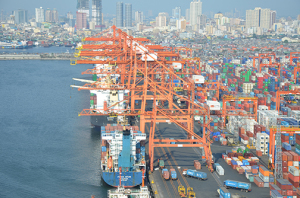
Congestion at Manila ports continues to ease three weeks after the city’s truck ban had been lifted.
During a port tour on October 7, International Container Terminal Services, Inc. (ICTSI) head of Asia Region Christian Gonzalez said truck movement at the Manila International Container Terminal (MICT) has increased 30% after the suspension of the Manila truck ban on September 13.
Yard utilization has, however, increased to 95% due to the recent long weekend but will decline by October 10. Vessel waiting time meantime has gone down by 73%.
To add more capacity to its flagship port MICT, ICTSI said it is now working to operationalize Berth 7, which will be completed in four phases. The first phase will be operational in about 60 days.
In a Philippine Stock Exchange disclosure also on Oct 7, ICTSI reiterated that it is fast-tracking construction of new yard facilities at the MICT and at a new 21-hectare Inland Container Depot (ICD) in Laguna in anticipation of a surge in trade and sustained growth of the Philippine economy.
As a result, ICTSI’s Board of Directors recently approved a $35-million capital expenditure for MICT. The Board likewise approved the estimated budget of $30 million for the ICD for its remaining 15 hectares since ICTSI has previously used six hectares of the said property. The $310 million estimated capex for the entire ICTSI Group remains the same and has only been re-allocated for these purposes, the company said in its disclosure.
Meanwhile, in a separate briefing at the nearby Manila South Harbor, Asian Terminals Inc. (ATI) vice president for marketing and commercial services Sean Perez said truck movement at the facility has increased 40% since the lifting of the truck ban.
Just like at MICT, the long weekend caused an increase in Manila South Harbor’s yard utilization to 94% which will ease to about 85% in a few days, according to Perez.
By December, he said yard utilization at the South Harbor should not be more than 80%.
As of October 7, Perez said there are six vessels waiting to berth at the South Harbor with an average waiting time of four days compared to nine vessels waiting to berth with an average waiting time of nine days previously.
He noted that ATI started a month ago a Web-based traffic system for returning empty containers that advises waiting truckers whether there is space at the port for their empties per shipping line allocation.
ATI has also begun expanding a 4-hectare space near its main container yard in South Harbor, which would increase capacity by 2,500 twenty-foot equivalent units.
“We’re now demolishing and we’ll flatten it to create a yard,” Perez told PortCalls after the briefing. He said the new space will be operational in the third quarter of 2015.
The truck holding area at South Harbor, currently able to accommodate 250 trucks, is also being expanded. The first section will be able to handle 100 trucks and the second another 150 trucks. Full operation of the additional holding areas will be by end of next year.
Senator Paolo Benigno “Bam” Aquino IV, which led the port tour at MICT and South Harbor, said while “physical congestion” at Manila ports has improved since the lifting of the truck ban, the government is now looking at “corruption” in the port area and extortion from truck drivers.
Aquino said some “vultures” are taking advantage of port congestion and are asking P2,000 to P4,000 to expedite release of containers.
Involved in the corruption are a mix of private and government agencies, he said, although he declined to name any entity. A Senate hearing on October 16 will delve more deeply into the matter.
Aquino said aside from resolving the corruption issue, there should be talks for long-term solutions such as connector roads and the country’s “need for larger and better infrastructures for our ports.”
Meanwhile, the Philippine Ports Authority declined to forecast when the port situation will normalize but said they will closely monitor conditions in the next two to three weeks considering the influx of cargoes for the holiday season. – Roumina Pablo





